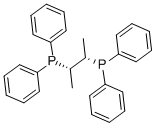ETHYLDIPHENYLPHOSPHINE
Synonym(s):Diphenylethylphosphine;NSC 151254
- CAS NO.:607-01-2
- Empirical Formula: C14H15P
- Molecular Weight: 214.24
- MDL number: MFCD00015170
- EINECS: 627-386-9
- SAFETY DATA SHEET (SDS)
- Update Date: 2024-12-18 14:15:30

What is ETHYLDIPHENYLPHOSPHINE?
Chemical properties
clear colorless liquid
The Uses of ETHYLDIPHENYLPHOSPHINE
Catalyst for:
- Three component coupling reactions of arylaldehydes with Me vinyl ketone and phthalimide
- Regio- and stereoselective hydroalkynylation of methylenecyclopropanes
- Synthesis of oxazolidines, thiazolidines, pyrrolidines, and indoles
- Dimer to monomer conversion
- Tandem Morita-Baylis-Hillman/Michael addition reactions
- Platinum-catalyzed cyclization
- Regioselective and stereoselective [3+2] cycloaddition
- Platinum-catalyzed intermolecular hydroamination
- Hydroformylation reactions
What are the applications of Application
Ethyldiphenylphosphine is a ligand used in organometallic chemistry
Properties of ETHYLDIPHENYLPHOSPHINE
| Boiling point: | 293 °C(lit.) |
| Density | 1.048 g/mL at 25 °C(lit.) |
| refractive index | n |
| Flash point: | >230 °F |
| storage temp. | under inert gas (nitrogen or Argon) at 2-8°C |
| form | Liquid |
| color | Clear colorless |
| Specific Gravity | 1.048 |
| Sensitive | Air Sensitive |
| BRN | 744253 |
| CAS DataBase Reference | 607-01-2(CAS DataBase Reference) |
| EPA Substance Registry System | Phosphine, ethyldiphenyl- (607-01-2) |
Safety information for ETHYLDIPHENYLPHOSPHINE
| Signal word | Warning |
| Pictogram(s) |
 Exclamation Mark Irritant GHS07 |
| GHS Hazard Statements |
H302:Acute toxicity,oral H315:Skin corrosion/irritation H319:Serious eye damage/eye irritation H335:Specific target organ toxicity, single exposure;Respiratory tract irritation |
| Precautionary Statement Codes |
P261:Avoid breathing dust/fume/gas/mist/vapours/spray. P264:Wash hands thoroughly after handling. P264:Wash skin thouroughly after handling. P270:Do not eat, drink or smoke when using this product. P301+P312:IF SWALLOWED: call a POISON CENTER or doctor/physician IF you feel unwell. P302+P352:IF ON SKIN: wash with plenty of soap and water. P305+P351+P338:IF IN EYES: Rinse cautiously with water for several minutes. Remove contact lenses, if present and easy to do. Continuerinsing. |
Computed Descriptors for ETHYLDIPHENYLPHOSPHINE
New Products
(S)-3-Aminobutanenitrile hydrochloride 4-Methylphenylacetic acid N-Boc-D-alaninol N-BOC-D/L-ALANINOL Tert-butyl bis(2-chloroethyl)carbamate 3-Morpholino-1-(4-nitrophenyl)-5,6-dihydropyridin- 2(1H)-one Furan-2,5-Dicarboxylic Acid Tropic acid 1-Bromo-3,5-Di-Tert-Butylbenzene S-2-CHLORO PROPIONIC ACID ETHYL ISOCYANOACETATE 2-Bromo-1,3-Bis(Dimethylamino)Trimethinium Hexafluorophosphate 4-IODO BENZOIC ACID 3-NITRO-2-METHYL ANILINE 1-(2,4-DICHLOROPHENYL) ETHANAMINE (2-Hydroxyphenyl)acetonitrile 4-Bromopyrazole 2-(Cyanocyclohexyl)acetic acid 4-methoxy-3,5-dinitropyridine 1-(4-(aminomethyl)benzyl)urea hydrochloride 2-aminopropyl benzoate hydrochloride diethyl 2-(2-((tertbutoxycarbonyl)amino) ethyl)malonate tert-butyl 4- (ureidomethyl)benzylcarbamate Ethyl-2-chloro((4-methoxyphenyl)hydrazono)acetateRelated products of tetrahydrofuran








You may like
-
 Ethyldiphenylphosphine 95% CAS 607-01-2View Details
Ethyldiphenylphosphine 95% CAS 607-01-2View Details
607-01-2 -
 Ethyldiphenylphosphine CAS 607-01-2View Details
Ethyldiphenylphosphine CAS 607-01-2View Details
607-01-2 -
 Ethyldiphenylphosphine CAS 607-01-2View Details
Ethyldiphenylphosphine CAS 607-01-2View Details
607-01-2 -
 1975-50-4 98%View Details
1975-50-4 98%View Details
1975-50-4 -
 2-HYDROXY BENZYL ALCOHOL 98%View Details
2-HYDROXY BENZYL ALCOHOL 98%View Details
90-01-7 -
 2-Chloro-1,3-Bis(Dimethylamino)Trimethinium Hexafluorophosphate 221615-75-4 98%View Details
2-Chloro-1,3-Bis(Dimethylamino)Trimethinium Hexafluorophosphate 221615-75-4 98%View Details
221615-75-4 -
 14714-50-2 (2-Hydroxyphenyl)acetonitrile 98+View Details
14714-50-2 (2-Hydroxyphenyl)acetonitrile 98+View Details
14714-50-2 -
 118753-70-1 98+View Details
118753-70-1 98+View Details
118753-70-1
Statement: All products displayed on this website are only used for non medical purposes such as industrial applications or scientific research, and cannot be used for clinical diagnosis or treatment of humans or animals. They are not medicinal or edible.